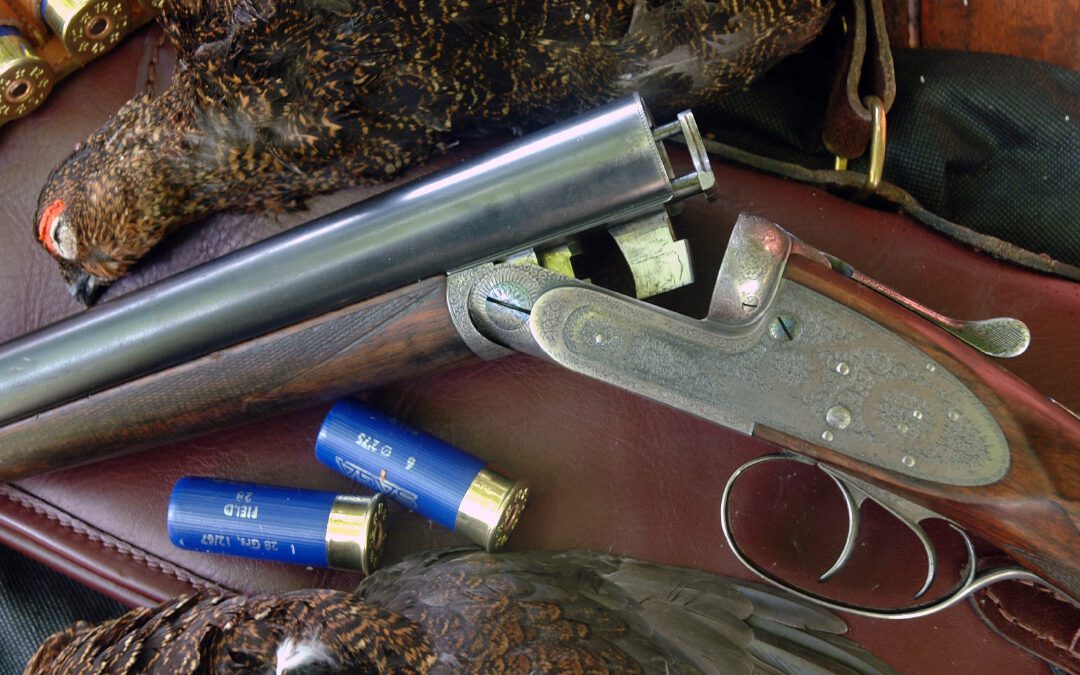The shotgun in hand that day was a borrowed 16-gauge Ithaca Model 37 pump. A farmer had loaned it to me to prowl a nearby woodlot after chores. The November evening was dark, clouds low and churlish. They muscled each other ahead of a capricious breeze that had just brought a shower. Pickets of naked poplars swayed gently over a carpet of chocolate leaves, pungent after the rain. I pushed deep into mixed cover, and almost jumped out of my boots. No matter that you know you’re in their thickets, or even hunting them, grouse-thunder has that effect.
This bird rocketed straight away, dodged a popple, cleared a tangle of wild grape, then hurtled sideways through a lattice of limbs. The comb met my cheek. A charge of 7 1/2s shredded the plume of a struggling cedar. In the silence I shucked the empty from the 37’s belly. Off the mark again. And late.
I had never hit a grouse.
Then, in a tickle of breeze, a feather floated in Ruff’s wake. A spasm of wing-beats drummed the earth 20 strides on. I covered them in trice. The beautiful bird stopped its flutter.
I missed a lot of grouse after that, and hit a few. When I left Michigan for graduate school in the West, the scent of wet poplar stands stayed behind. So did the explosions that drew me to thickets within, and the tittering ascents of woodcock on their layovers between night flights.
If it yielded nothing of commercial value, I decided the upper Midwest would endear itself to any hunter who eased through wooded bottoms at leaf-drop.
Chukars stood in for a while. They blasted like grenade shards from rocky rims above the Salmon and the Snake, streaking to the knees of distant ridges, vanishing in cheatgrass and sage as they raced up steep basalt skirts. There were no popples to intercept my pellets; but the speed of these buzzbombs, the crazy shot angles and long, arduous hikes for second chances made a limit of birds as elusive as interest-free loans. When on the rare occasion a bird went limp in a burst of feathers and plunged into the abyss, the event seemed a miracle. Had I called a miss or a hit? Good grief! I’d had barely enough time to point!
“Pulllll!” I swung the Krieghoff fast at the bird crossing hard from 3 o’clock. Pulverized, it hung as black dust. I nudged the barrels, firing the top tube as it drove past the second disk. Another smudge in the sky. In my dreams. The truth was humbling—more so in the company of skilled shotgunners. But you can’t tumble chukars or grouse if you can’t hit clay disks on rail-stiff arcs.
Thus, I’d shuffled to a sporting clays event in Mexico and given rapt attention to the techniques of paragons smoking targets that flew so fast and showed so little rim that even seeing them was difficult. A mini launched 80 yards out blitzed through forest that hid it until just before it struck earth a pebble’s toss away. Another, flung from 100 yards, winked out permanently in brush at 55!
While I didn’t blank a station or pepper a trap the first day, the second was brutal. After whiffing two stations, I gawked as an ace on my squad shattered true doubles that seemed impossible. I shouldn’t have missed at all with that long-stocked Krieghoff. It came as close to matching my 36-inch sleeve as any shotgun. Its perfect balance and long tubes smoothed my swing. But miss I did.
So it was with some trepidation that I told Dave, “Sure. We can at least try.”
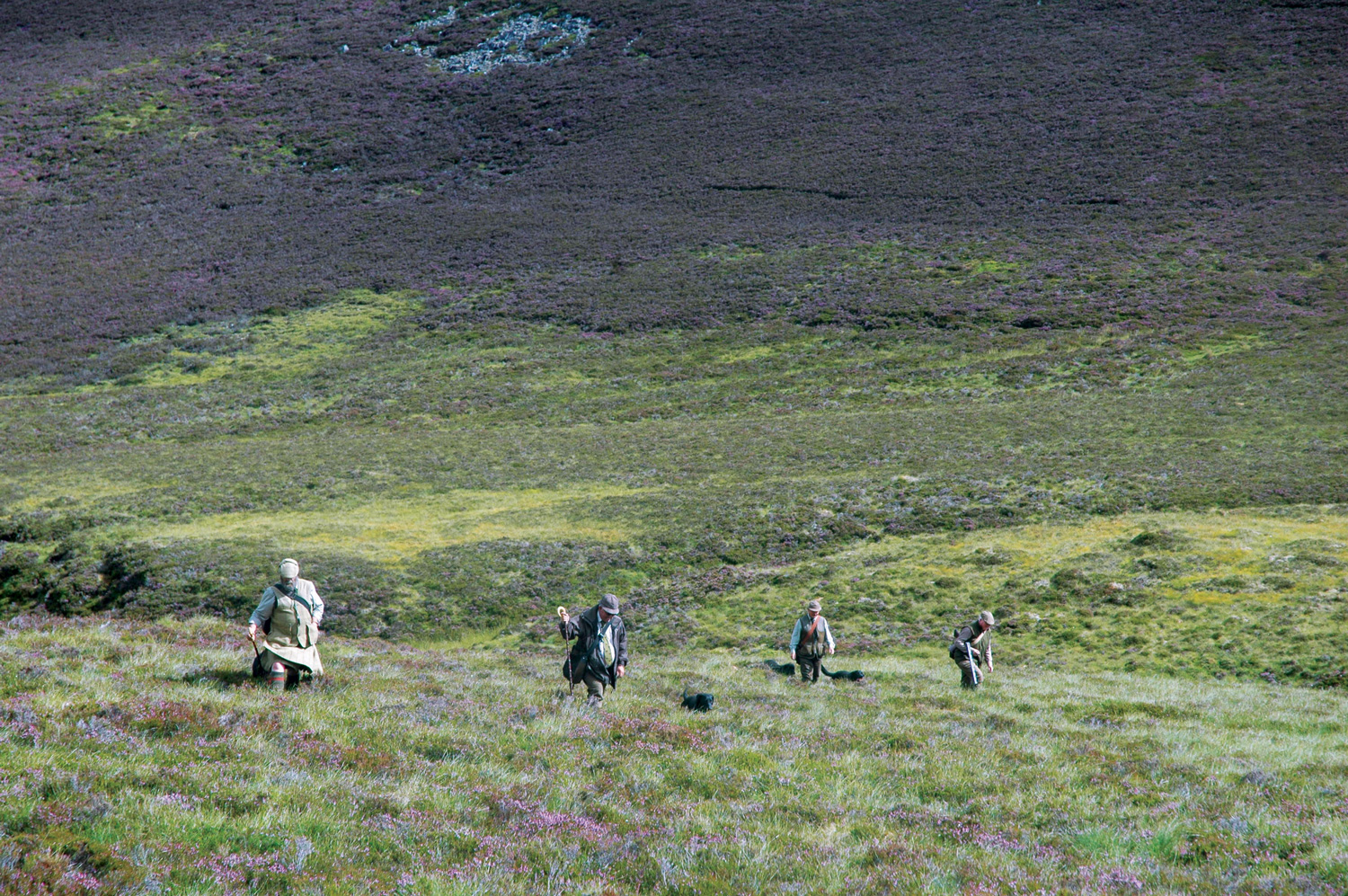
Dave Anderson and his wife Simone had joined my wife, Alice, and me in Scotland, on a joint anniversary trip to include a couple of days chasing stags on the moors. Applied mostly to Britain’s rural north, “moor” appears in Webster’s as “open, rolling wasteland, usually covered with heather and often marshy or peaty; heath.” Green hills and bogs rolled by as we motored up-country. Sheep dotted the lower slopes; morning fog shrouded the crests. At an old stone farmhouse, we disembarked. Afoot behind the gillie, we climbed into lofty basins where stags lived. Hewing to custom, our host insisted on carrying the rifle until we had crept within range for a shot….
As exciting to me was the prospect of lodging at the retirement home of celebrated ivory hunter Walter Dalrymple Maitland Bell. To his enduring credit, Dave had come up with that idea, and followed through with arrangements. Narrow pavement left settlements behind to wind through forested hills and skirt crystalline lakes into the Highlands, where we found Corriemoillie, Bell’s Ross-Shire estate.
The large if not imposing house was tucked into a south-facing bench over a wooded drive. At 14 acres, the plot hardly did justice to the original property, a dowry. When Bell married Katie Soames after his stint on the Balkan Front in WW I, the Corriemoillie tract comprised thousands of acres. Subsequent sales chiseled away much of the valley and the march of hills to the north. Willie and Sharon Wright had bought the house and grounds and had tried to maintain the building’s original character. Alas, expansion of the living quarters erased Bell’s gun room.
The Wrights and their young children occupied the main and second-floor areas, periodically and selectively yielding the third-floor servants’ quarters to short-term visitors. Graciously, Sharon showed us up the narrow stairs to rooms in which Bell had sketched and painted. (One of his paintings was accepted for display at the Royal Academy.) A watercolor of elephants hung in the hallway.
Though the roof beams repeatedly bit my skull, it was a comfortable place to bunk and to fix our meals; a place rich with history.
Bell didn’t grow up there. Born into a wealthy Edinburgh family (say Edinborough) several hours’ drive to the south, he lost his parents at age six. Ten siblings tried in vain to curb his wanderlust, sparked early by his readings of Ronaleyn Gordon-Cumming of Altyre. An adventurer posted as a soldier to India, “Red Rory” was soon probing Africa’s bush for big game. In 1866, not long after he built a museum for his trophies, Red Rory died at age 46.
Following much the same path, Bell lived later and longer, and left more lasting reminders of his exploits. His book, Wanderings of an Elephant Hunter appeared in 1923. Karamojo Safari followed. Bell wrote more after retiring to Corriemoillie. He indulged a passion for sailing, too. His idea for a racing yacht became the 72-foot Trenchemere—the name at Katie’s behest, after Richard Lionheart’s red galley. Bell’s was the first British yacht with a steel skeleton. Its spruce mast towered nearly 100 feet above deck. In 1934 Trenchemere placed second in the Fastnet Race, a rigorous 600-mile run finishing at the Fastnet Rock off Ireland. A mild heart attack warned Bell off the sea in 1948. Six years later, another took his life. One of the last photographs of Bell shows him in Corriemoillie’s drive, nattily dressed, with a cane….
I digress. When Dave suggested we find a place to hunt grouse on Scotland’s opener, just days away, my dismal wing-shooting came instantly to mind. But I agreed. We soon found prospects laughably dim. “You need reservations to hunt grouse on the Glorious 12th,” our host explained. “Some moors host only returning clients. New shooters put their names on rosters months in advance in the event scheduled guests don’t show.” In other words, we were as likely to snare seats in an owner’s box at the Super Bowl.
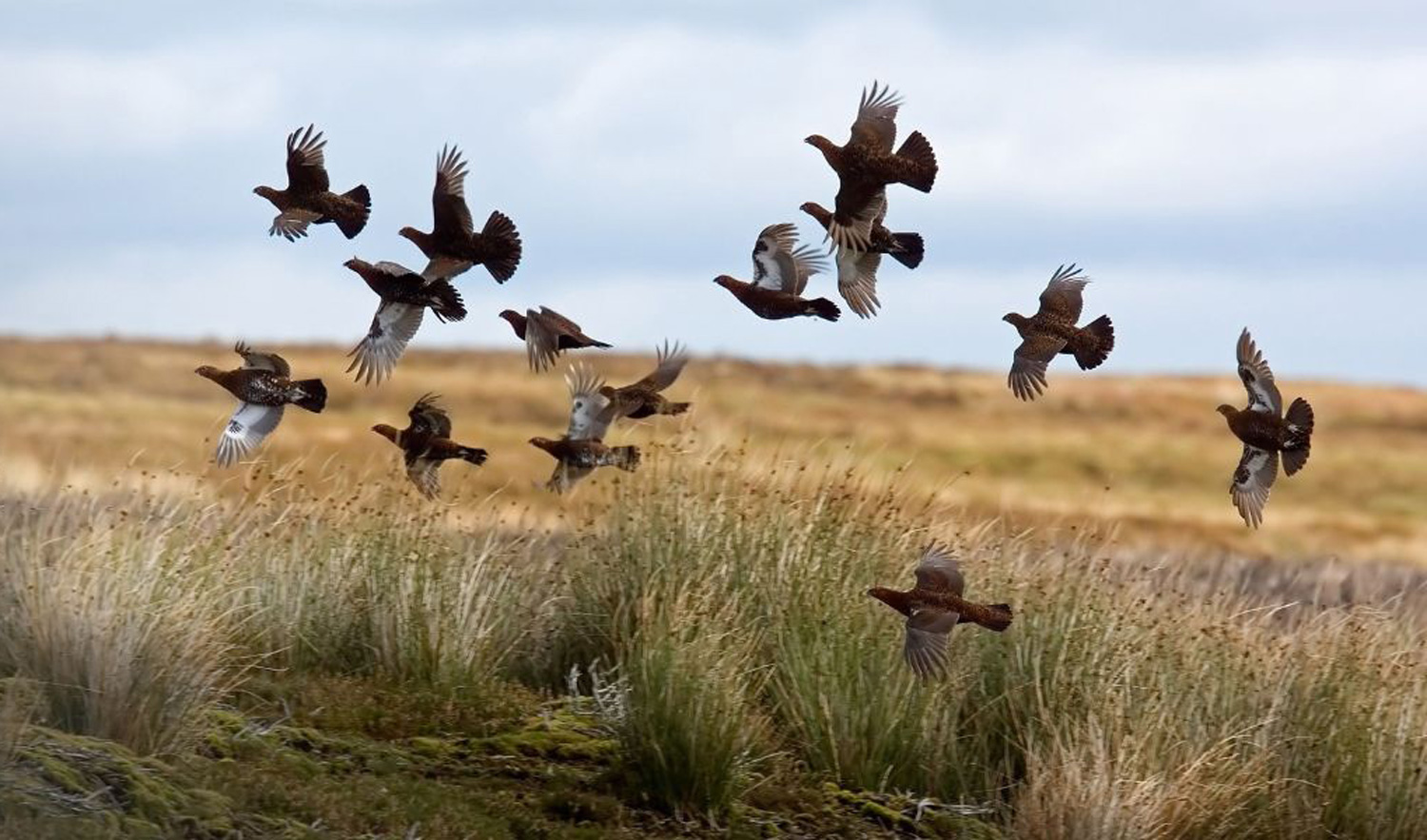
Laopus lagopus, scientific name for Great Britain’s native red grouse, is shared with the willow ptarmigan of North America. But as the Atlantic Ocean is a formidable barrier, the two birds evolved as separate subspecies. In northern England, Wales and Scotland, grouse bear the subspecies label scotia. In Ireland their plumage is of slightly different hue, prompting some taxonomists to distinguish these grouse as hibernicus. Red grouse do not endure the snows of our Far North, so they don’t molt to white in winter, like willow and rock ptarmigan. Russet body plumage has white wing and tail accents. A red brow or eye wattle becomes brilliant during mating season. Color on females is less intense.
These birds like to roost, loaf and forage in small coveys spread through the heather. A single rise doesn’t always trigger a mass exodus. They call in clucks and loud nasal clacks that commonly end in a trill. Quick and thunderous at launch, they accelerate fast, to zip over the heath at up to 70 mph. Roughly half a million grouse are shot annually by hunters in the British Isles. Many more, I’m sure, are missed.
Red grouse and heather go together like ruffed grouse and northern Michigan woodlots. Periodic burning bolsters grouse numbers with heather of staggered ages or seral stages, much as burns in North America supplant mature, sterile forests with second-growth that benefits big game. Red grouse habitat covers 12 to 18 percent of Scotland’s 80,000 square kilometers. Most of it lies in privately held estates.
Landowners hosting hunters have a financial stake in their grouse. The average cost of a brace of these birds has risen to an estimated £200 (about $256)!
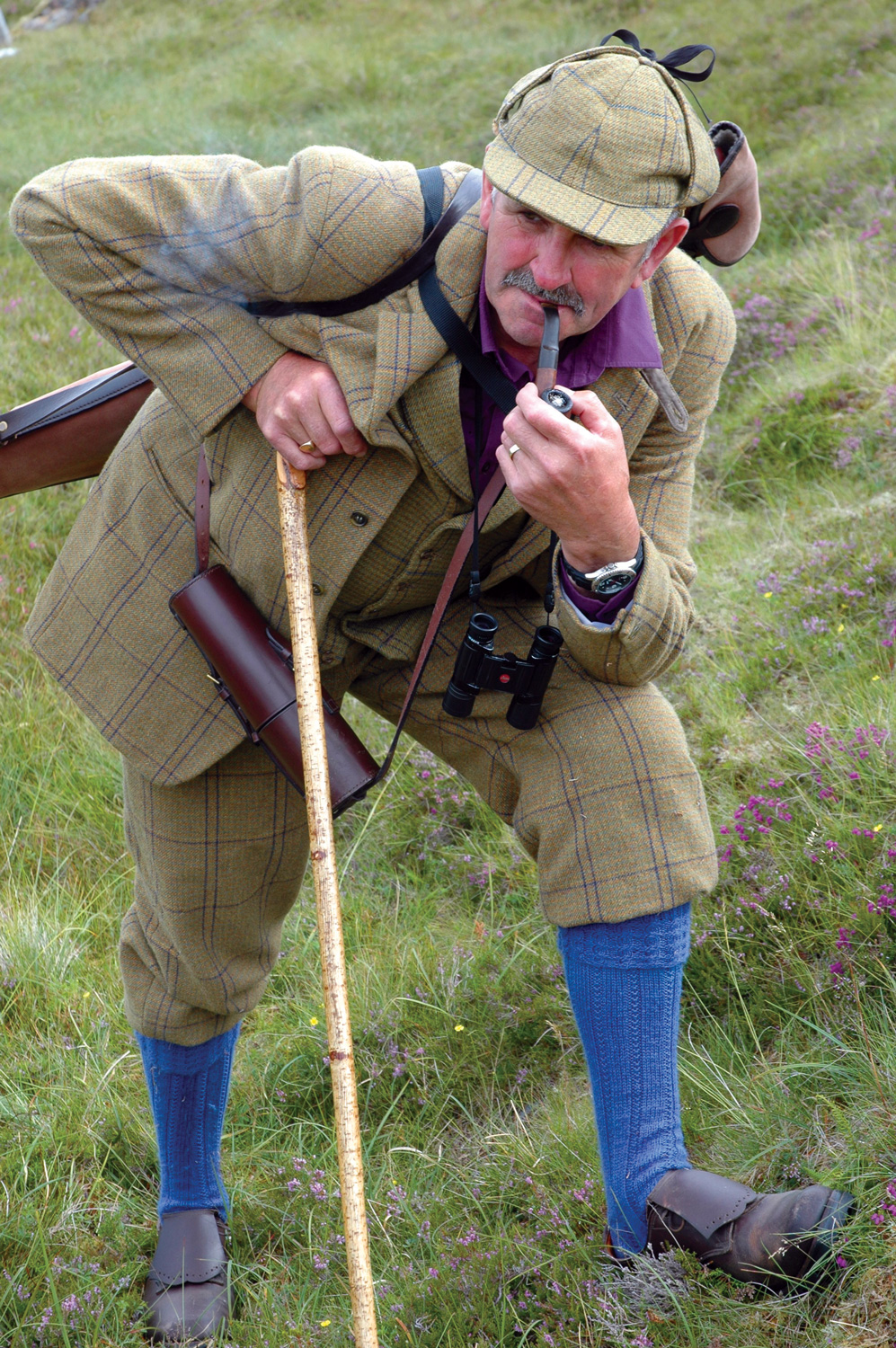
Formal dress, here on a gillie (gamekeeper), is customary if not required for hunters on Scottish estates.
The “Glorious 12th” has its roots in legislation. The Game Act of 1831 set opening day of grouse season as August 12, scuttling a previous ruling that nixed hunting from August through December. That opening date has remained for 193 years; there’s no indication it will change anytime soon! (English Law prohibits Sunday hunting, so when the 12th falls on a Sunday, hunters must wait for the 13th.) Grouse are traditionally hunted until December 10 in Scotland, Wales and northern England. Ireland’s season ends November 30. Those schedules don’t apply to all game. The opener for some species is September 1; for woodcock and pheasant October 1.
Reverberations of the Glorious 12th are felt far to the south. High-brow London restaurants speed grouse by rail to their tables to serve discerning customers with birds shot that morning. According to one reporter, opening day is “followed by five months where grouse is all over restaurant menus, revered by chefs for its exclusivity and earthy flavour.”
When the Game Act of 1831 was passed, most grouse hunters walked the heather in small groups, lined out to best cover the ground and keep shot patterns safely ahead of the guns. That method remains popular. But the 1850s brought rail service north, and affluent sportsmen from London. Landowners built butts in which to post shooters with pairs of guns and lads to keep them loaded. Gamekeepers and local hirelings served as beaters, sending birds over the butts. It became a fashionable way to kill grouse in the waning years of Victorian England.
During the 1940s, landowners gathered neighbors for regular walk-up hunts to garner meat of any kind, rationed during WW II. “Moorcock,” or “moorfowl,” as red grouse were called, comprised much of an ordinary day’s bag. Young birds were commonly roasted; aged grouse were pieced into casseroles and stews. A generation of young men grew up depending, at least in part, on local heath for sustenance. They owed the moors careful husbandry—a perspective that has since figured heavily in conserving grouse and preserving grouse hunting. The Glorious 12th is an annual reminder of that debt.
Learning of this, Dave and I despaired of participating. My suggestion that we try to attend a hunt as observers or beaters went nowhere. “Groups are kept small,” said Sharon, “and honestly, they’re quite exclusive. Anyone invited to an estate or into a grouse-hunting party holds tight to his spot unless forced by personal circumstance to give it up, lest someone else take it.” Clearly, we were behind a long queue. Given what we’d been told, knocking on doors would have been both fruitless and embarrassing.
Visions of grouse raining from Scottish skies were shelved as we four nosed about rural towns in search of local color. We found it in what stateside would be a county fair. Youngsters stepped high to the wail of bagpipes, the music and moves perfectly timed and as tirelessly rendered. Thick-muscled farmers threw all manner of heavy implements: a 22-pound hammer, the 28-pound Braemer stone (hurled with no running start), the 17-foot 150-pound caber. Backbreakers all! A footrace followed to a nearby hilltop. Perhaps a mile, round trip. Hmmm.
Registration had ended when I dashed to the table and asked a comely lass if I could still enter. She beamed a smile, handed me a number and pins. The field, I noted as the gun popped, was young and athletic. A week in airplanes and the sedan had wrung all the marathon juice from my legs. The hill was farther off than it had looked. While I didn’t require a stretcher or finish dead last, no one asked for my autograph.
When we pulled into Corriemoillie’s drive that evening, Sharon hurried to meet us. “After you asked about hunting on the 12th, I put out the word,” She grinned. “I thought you’d have no chance, but a friend telephoned today. There are two cancellations. I held them for you. The property is not far. Do you want me to confirm for you?”
“Yes!” Dave and I bellowed at once.
We drove to the estate early.
The farmhouse, once fully staffed, showed a bit of wear now. But it was big, and its patina held a dim glow of Victorian grandness. The young man who answered our knock was engaging. His dungarees and hooded sweatshirt reminded me of milking time at a Michigan dairy. He ushered us into a kitchen dominated by an enormous wood-burning cook-stove. Pouring two coffees from a tall, blackened pot, he retrieved his and said: “So, you’ve brought no guns.”
My pulse skipped. Surely, he has a couple of spares. Even one. We could take turns!
“Let’s see what we can find.”
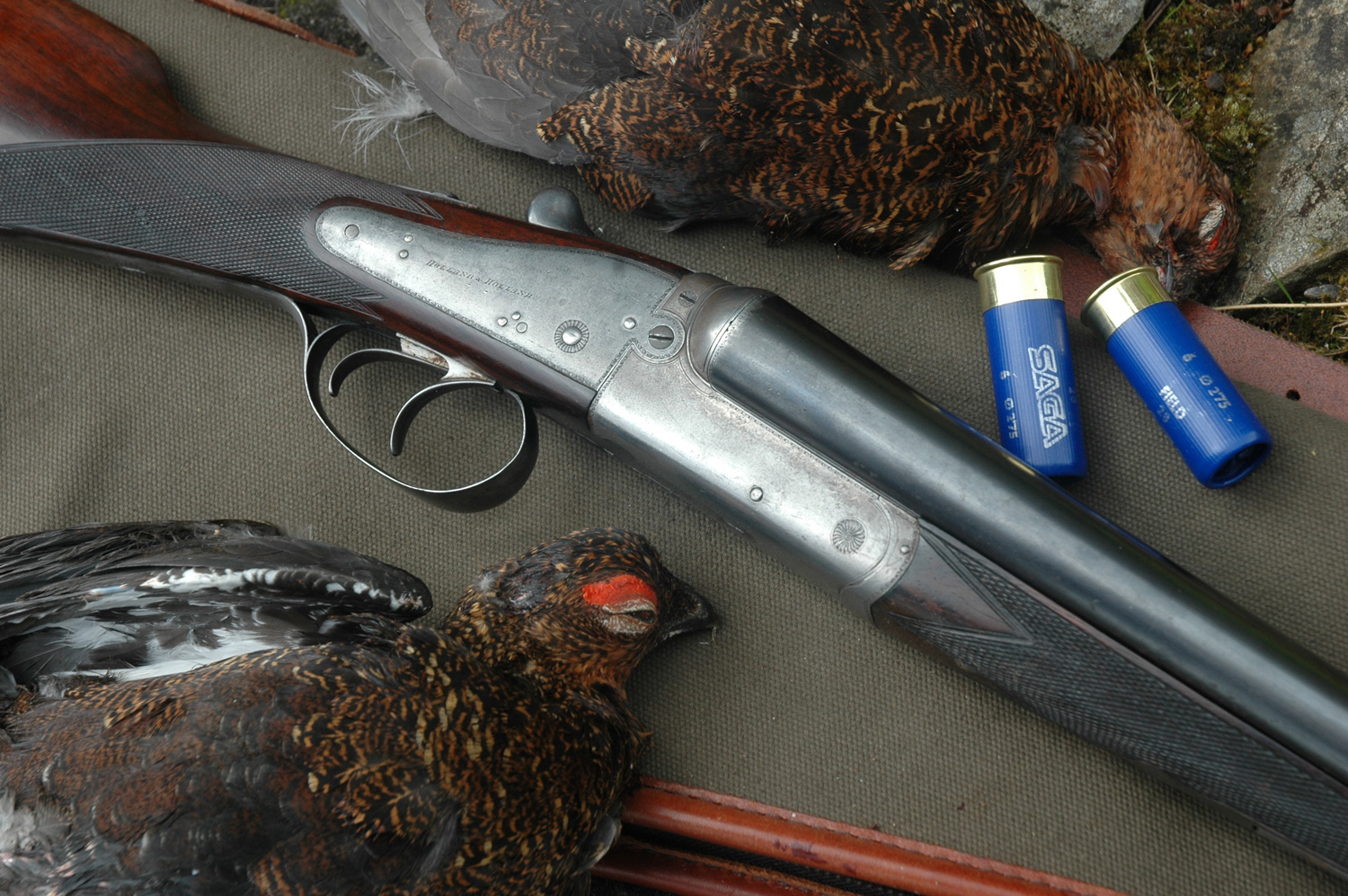
The back-action 12-bore Holland & Holland Wayne used was old but tight. It downed several grouse.
Under a bare bulb in a closet under the stairs, he parted overcoats and, as casually as if it were a broom, pulled out a use-silvered Holland & Holland back-action sidelock. “The stock is longish. Should fit you.” He handed it to me. I gaped as he pawed through slickers and retrieved another 12-bore double. A Purdey. Dave’s eyes bugged. “I might have a Japanese over/under, should one of you prefer….”
“No!” Again, in unison.
Early in my shotgunning career, I’d found side-by-sides difficult. My rifleman’s eye didn’t know what to do with that runway of steel and the natural curl of my big hand around twin tubes over sliver forends hid birds. But this day, repeating shotguns and over/unders were non-starters. The chance to prowl Scottish heather on the Glorious 12th with a vintage Holland double was a rare treat, however many grouse I was doomed to miss!
Clutching our treasures, we finished the coffee and in due time were motoring up the mountain in a battered Land Rover. Other gunners and the dogs and their handlers followed. Piling out streamside in a high valley, we bundled against damp cold under low, sooty clouds.
The hunt-master, a big man with neatly trimmed beard, wore a kilt and tailored shirt, with tie and vest and jacket becoming his station. He gave us a briefing, then strode ahead on heavily muscled legs, a dog handler in similar attire loosing three of four deep-chested black Labs. Eagerly, they surged into the heather, a green ocean that rolled in all directions to lap at dim horizons. Soon we six shooters had spread in a slowly advancing line, the dogs coursing efficiently to the limits of shotgun range. The heather came only to my shins, but was knee-high to the Labs, and in places quite thick. They would earn their supper.
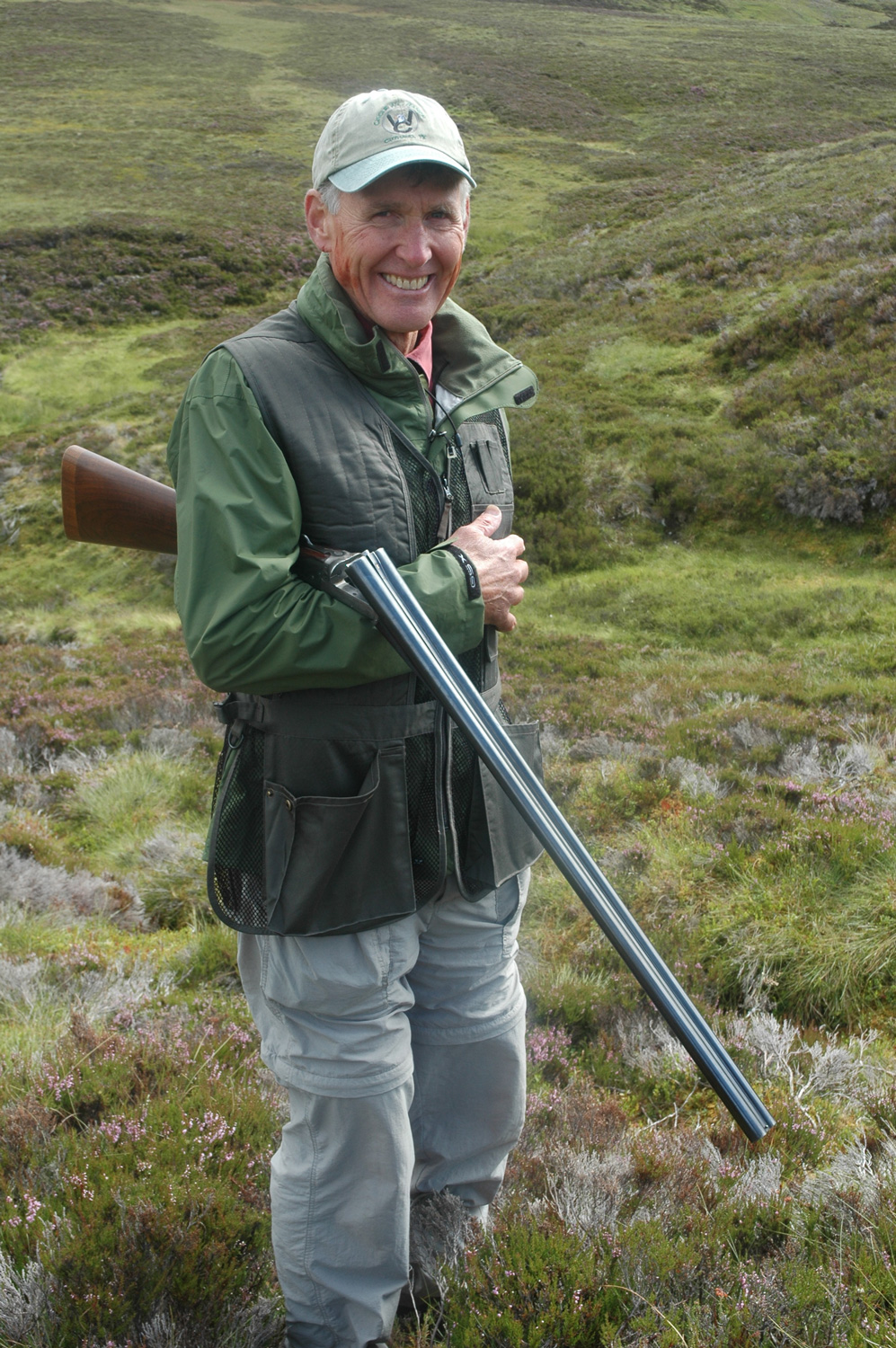
Cradling a Holland double in Scottish heather is a sure way to bring on a smile.
Bang! The grouse kept going, low and straight. A gunner to my left muttered and reloaded. The next bird rose to my front, bullet-fast and quartering off. But it had launched a mere five steps away. The Holland pointed itself and bounced gently. Feathers puffed, and my first red grouse tumbled to the charge of No. 7s. At that point I didn’t care if I killed another bird! I had hunted grouse in Scotland with a London double on the Glorious 12th!
We continued on, zig-zagging a bit as Labs allowed, pausing so shooters could retrieve downed birds from their mouths.
On that initial sweep, two shooters walking a low ridge on the line’s right flank got most of the action. Singles, doubles and rises comprising up to half a dozen birds zipped across the sky, their flight like that of sharp-tails in our mountain West. Faint pops followed the few grouse that angled steeply into the heath. While the broad swale cradling the line’s center yielded no coveys, enough birds rose to bring action to every shooter.
Mid-morning we watered and rested the dogs and broke out sandwiches and tea. Then we turned to rake the valley’s opposite side.
The sky got dark as more grouse thundered off. Six of them fell to my shotgun before driving rain just after noon called an early halt to our hunt.
Dripping before we reached the Land Rovers, hunters and Labs loaded up for the return on a track now muddied. Wipers slapped the windscreen rhythmically as if marking time, closing in on the end of another Glorious 12th.
At the farmhouse, our host gently pried the Holland from my hands.
What is the Famous Grouse?
The most coveted grouse in some circles is the Famous Grouse, a blended scotch whisky dating to 1896. Versatile and inexpensive, it is a sweet, smooth scotch for everyday consumption–“neat, on the rocks or with water or Coke.”
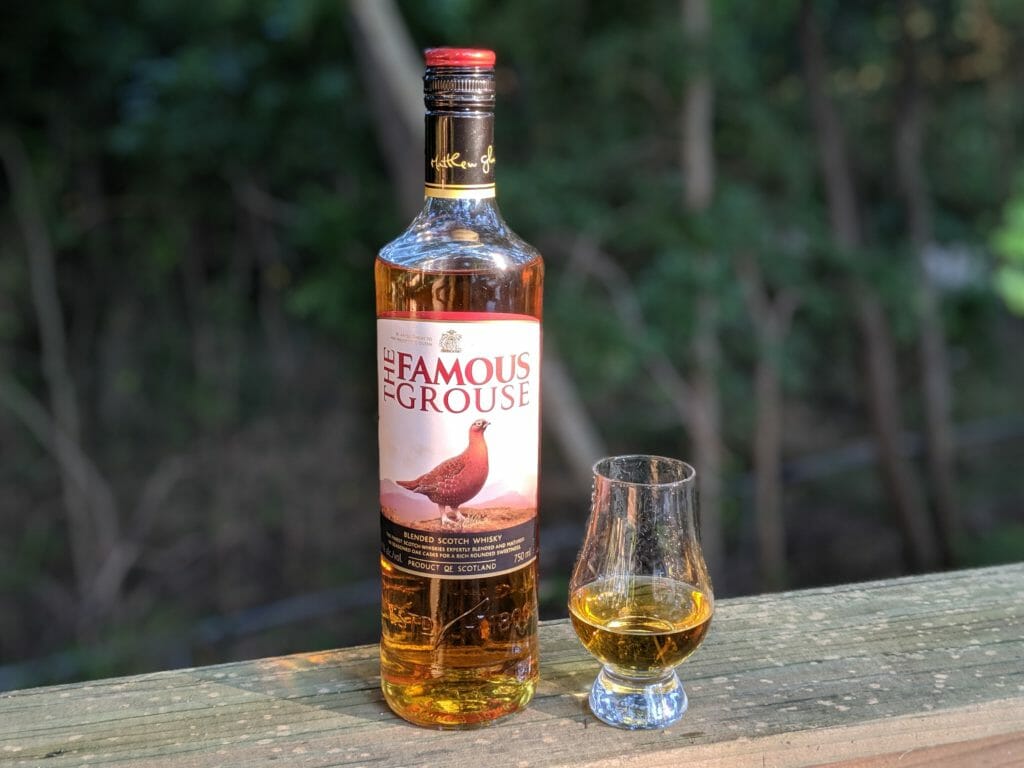
Some connoisseurs give it mediocre marks, if they deign to rate it at all. But among its legions of faithful are enthusiasts of long, if occasionally blurred, experience. One who has worked in the industry for more than 40 years points out that blended scotch is 90 percent of all scotch and that single-malt distilleries would fail en masse if blends didn’t take most of their product. “Being snobbish about blended scotch is idiotic…. Every bar in Scotland sells Grouse. It is solid, unadventurous and consistent [and across a wide demographic swath] the default choice of whisky drinkers.”

